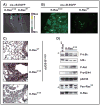Requirement of the NF-kappaB subunit p65/RelA for K-Ras-induced lung tumorigenesis
- PMID: 20406971
- PMCID: PMC2862109
- DOI: 10.1158/0008-5472.CAN-09-4290
Requirement of the NF-kappaB subunit p65/RelA for K-Ras-induced lung tumorigenesis
Abstract
K-Ras-induced lung cancer is a very common disease, for which there are currently no effective therapies. Because therapy directly targeting the activity of oncogenic Ras has been unsuccessful, a different approach for novel therapy design is to identify critical Ras downstream oncogenic targets. Given that oncogenic Ras proteins activate the transcription factor NF-kappaB, and the importance of NF-kappaB in oncogenesis, we hypothesized that NF-kappaB would be an important K-Ras target in lung cancer. To address this hypothesis, we generated a NF-kappaB-EGFP reporter mouse model of K-Ras-induced lung cancer and determined that K-Ras activates NF-kappaB in lung tumors in situ. Furthermore, a mouse model was generated where activation of oncogenic K-Ras in lung cells was coupled with inactivation of the NF-kappaB subunit p65/RelA. In this model, deletion of p65/RelA reduces the number of K-Ras-induced lung tumors both in the presence and in the absence of the tumor suppressor p53. Lung tumors with loss of p65/RelA have higher numbers of apoptotic cells, reduced spread, and lower grade. Using lung cell lines expressing oncogenic K-Ras, we show that NF-kappaB is activated in these cells in a K-Ras-dependent manner and that NF-kappaB activation by K-Ras requires inhibitor of kappaB kinase beta (IKKbeta) kinase activity. Taken together, these results show the importance of the NF-kappaB subunit p65/RelA in K-Ras-induced lung transformation and identify IKKbeta as a potential therapeutic target for K-Ras-induced lung cancer.
(c)2010 AACR.
Figures






Similar articles
-
A novel NF-kappaB pathway involving IKKbeta and p65/RelA Ser-536 phosphorylation results in p53 Inhibition in the absence of NF-kappaB transcriptional activity.J Biol Chem. 2005 Mar 18;280(11):10326-32. doi: 10.1074/jbc.M412643200. Epub 2004 Dec 20. J Biol Chem. 2005. PMID: 15611068
-
Immortalized fibroblasts from NF-kappaB RelA knockout mice show phenotypic heterogeneity and maintain increased sensitivity to tumor necrosis factor alpha after transformation by v-Ras.Oncogene. 2005 Sep 29;24(43):6574-83. doi: 10.1038/sj.onc.1208809. Oncogene. 2005. PMID: 16027734
-
Mutations of p53 and KRAS activate NF-κB to promote chemoresistance and tumorigenesis via dysregulation of cell cycle and suppression of apoptosis in lung cancer cells.Cancer Lett. 2015 Feb 28;357(2):520-6. doi: 10.1016/j.canlet.2014.12.003. Epub 2014 Dec 8. Cancer Lett. 2015. PMID: 25499080
-
Reprogramming RelA.Cell Cycle. 2004 Jul;3(7):869-72. Epub 2004 Jul 4. Cell Cycle. 2004. PMID: 15190199 Review.
-
NF-kappaB fans the flames of lung carcinogenesis.Cancer Prev Res (Phila). 2010 Apr;3(4):403-5. doi: 10.1158/1940-6207.CAPR-10-0042. Epub 2010 Mar 30. Cancer Prev Res (Phila). 2010. PMID: 20354166 Free PMC article. Review.
Cited by
-
Reverse engineering a hierarchical regulatory network downstream of oncogenic KRAS.Mol Syst Biol. 2012;8:601. doi: 10.1038/msb.2012.32. Mol Syst Biol. 2012. PMID: 22864383 Free PMC article.
-
GSK-3α promotes oncogenic KRAS function in pancreatic cancer via TAK1-TAB stabilization and regulation of noncanonical NF-κB.Cancer Discov. 2013 Jun;3(6):690-703. doi: 10.1158/2159-8290.CD-12-0541. Epub 2013 Apr 1. Cancer Discov. 2013. PMID: 23547054 Free PMC article.
-
The BCR-ABL/NF-κB signal transduction network: a long lasting relationship in Philadelphia positive Leukemias.Oncotarget. 2016 Oct 4;7(40):66287-66298. doi: 10.18632/oncotarget.11507. Oncotarget. 2016. PMID: 27563822 Free PMC article. Review.
-
If Virchow and Ehrlich Had Dreamt Together: What the Future Holds for KRAS-Mutant Lung Cancer.Int J Mol Sci. 2021 Mar 16;22(6):3025. doi: 10.3390/ijms22063025. Int J Mol Sci. 2021. PMID: 33809660 Free PMC article. Review.
-
Constitutive IKK2 activation in intestinal epithelial cells induces intestinal tumors in mice.J Clin Invest. 2011 Jul;121(7):2781-93. doi: 10.1172/JCI45349. Epub 2011 Jun 23. J Clin Invest. 2011. PMID: 21701067 Free PMC article.
References
-
- Jemal A, Siegel R, Ward E, Hao Y, Xu J, Thun MJ. Cancer Statistics, 2009. CA Cancer J Clin. 2009;59:225–49. - PubMed
-
- Mills NE, Fishman CL, Rom WN, Dubin N, Jacobson DR. Increased Prevalence of K-ras Oncogene Mutations in Lung Adenocarcinoma. Cancer Res. 1995;55:1444–7. - PubMed
-
- Rodenhuis S, Slebos RJ. Clinical significance of ras oncogene activation in human lung cancer. Cancer Res. 1992;52:2665s–9s. - PubMed
-
- Slebos RJ, Rodenhuis S. The ras gene family in human non-small-cell lung cancer. J Natl Cancer Inst Monogr. 1992:23–9. - PubMed
-
- Graziano SL, Gamble GP, Newman NB, Abbott LZ, Rooney M, Mookherjee S, et al. Prognostic Significance of K-ras Codon 12 Mutations in Patients With Resected Stage I and II Non–Small-Cell Lung Cancer. J Clin Oncol. 1999;17:668. - PubMed
Publication types
MeSH terms
Substances
Grants and funding
LinkOut - more resources
Full Text Sources
Other Literature Sources
Medical
Molecular Biology Databases
Research Materials
Miscellaneous

